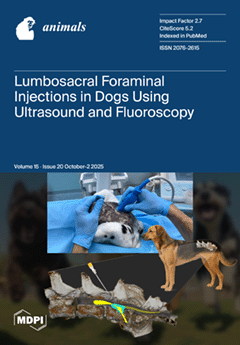This experiment investigated the effects of seaweed polysaccharide (SP) and seaweed enzymatic hydrolysate (SEH) on the growth performance, serum biochemical indices, antioxidant capacity, and intestinal function of Muscovy ducks. A total of 240 healthy 1 day female Muscovy ducks (48.85 ± 0.45 g) were randomly divided into 3 treatment groups, with 4 replicates per group and 20 ducks per replicate. The control (CON) group received a basic diet supplemented with 20 mL/kg of water, the SP group received a basic diet supplemented with 20 mL/kg of SP, and the SEH group received a basic diet supplemented with 20 mL/kg of SEH. The experimental period lasted for 28 d. The results indicate that, compared to the CON group, the average daily feed intake (ADFI) and feed to gain (F/G) of the SP and SEH groups of ducks significantly decreased at 28 d (
p < 0.05). In the SP group, serum levels of alanine aminotransferase (ALT) and aspartate aminotransferase (AST), as well as the concentrations of glucose (GLU), triglycerides (TG), total cholesterol (TCHO), low-density lipoprotein cholesterol (LDL-C), and high-density lipoprotein cholesterol (HDL-C), were significantly reduced (
p < 0.05). In the SEH group, the activities of ALT and AST were also significantly lower (
p < 0.05). Additionally, serum total antioxidant capacity (T-AOC) levels and superoxide dismutase (SOD) activity in the SEH group were significantly higher than those in the CON group (
p < 0.05), while the malondialdehyde (MDA) content was significantly reduced (
p < 0.05). Compared to the CON group, serum levels of immunoglobulin A (IgA), immunoglobulin G (IgG), interleukin-4 (IL-4), and interleukin-10 (IL-10) in the SP group were significantly increased (
p < 0.05), whereas the levels of tumor necrosis factor-alpha (TNF-α), interleukin-1 beta (IL-1β), and interleukin-6 (IL-6) were significantly decreased (
p < 0.05). In the SP and SEH groups, the villus height (VH) and the villus height to crypt depth (V/C) of the Muscovy ducks significantly increased (
p < 0.05), while the crypt depth (CD) significantly decreased (
p < 0.05). A significant increase in the abundance of
Barnesiella was observed in the SP and SEH groups (
p < 0.05), whereas the abundances of
UCG-005 and
Romboutsia significantly decreased (
p < 0.05). LEfSe analysis indicated that
g__Bacillus and
g__Veillonella were significantly abundant in the SP group (
p < 0.05), while
g__Coriobacteriaceae_UCG_002 was significantly abundant in the SEH group (
p < 0.05). In summary, the addition of SP and SEH to the feed can promote the healthy growth of ducks by improving intestinal morphology, regulating the structure of intestinal microbiota, enhancing antioxidant capacity and immune function, and optimizing metabolic indicators. This occurs while reducing feed intake and feed-to-weight ratio, and there is a certain specificity in their mechanisms of action.
Full article






